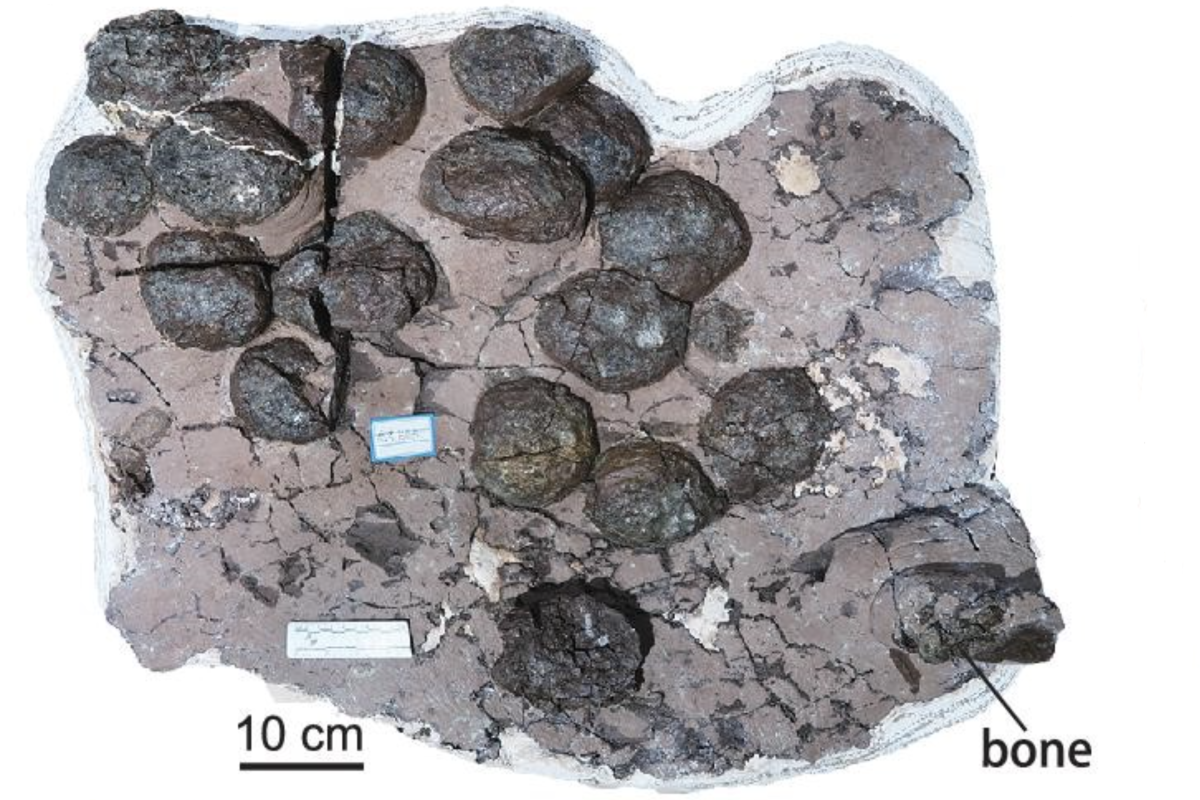Researchers have discovered a previously unknown dinosaur species that lived around 190 million years ago alongside dozens of its unhatched eggs.
A team from the Institute of Vertebrate Paleontology and Paleoanthropology (IVPP) of the Chinese Academy of Sciences (CAS) excavated fossils representing at least three adults of the new species in southwest China’s Guizhou Province, according to a study published in the journal National Science Review.
The newly identified species, which has been named Qianlong shouhu, belongs to a group of dinosaurs known as the sauropodomorphs, which contains sauropods and their ancestors.
Sauropods include the largest land-dwelling animals ever to walk the Earth. These dinosaurs, which could grow to colossal sizes, generally walked on four legs and are characterized by their very long necks, long tails, small heads and thick legs.

A clutch of 16 eggs and a fragmentary bone of the newly described dinosaur species, Qianlong shouhu. Researchers uncovered the remains of at least three adults and dozens of eggs in southwest China’s Guizhou Province.
Han et al., National Science Review 2023
Qianlong shouhu was a medium-sized sauropodomorph that measured roughly 20 feet in length and likely weighed around 1 ton.
Alongside the adult specimens, the Chinese researchers also uncovered around 50 fossilized eggs of the same species, spread out across five different nests, that contained the skeletal remains of the embryos inside them. Both the adults and the eggs are thought to date back to around 190 million years ago during the Jurassic period (201 million to 145 million years ago).
The discoveries may represent the earliest known fossil record of adult dinosaurs and their associated egg nests, according to the authors.
Analysis of the eggs demonstrated that they were elliptical in shape and relatively small. The analysis also revealed that the eggshells may have had a texture similar to leather—a discovery that sheds new light on our understanding of dinosaur reproduction.
In fact, the finds from Guizhou provide “strong evidence” for the earliest known “leathery” eggs, the authors wrote in the study. The discovery suggests that the first dinosaur egg was leathery in texture.
Referencing the nature of this finding, the name of the new species roughly translates to “a dragon in Guizhou that protects its embryos.”
Our understanding of dinosaur reproduction prior to the Cretaceous period—which followed the Jurassic, lasting from around 145 million to 66 million years ago—is hindered by a scarcity of fossils. But the new discovery helps to fill in some gaps in our knowledge.
The researchers’ analysis found that the shells of the eggs were semirigid, which challenges existing ideas about the nature of the earliest dinosaur eggs.
“After analysis, we came to believe its eggshell was semi-rigid, falling between soft ones like snakes’ eggs and rigid ones like hens’ eggs. Different from the existing arguments that the earliest dinosaurs’ eggs were soft or rigid, we argue for the first time that the earliest dinosaurs’ eggs were semi-rigid,” Han Fenglu, the first author of the study and a professor with the School of Earth Sciences at the China University of Geosciences in Wuhan, told the Chinese state-run media outlet the Global Times.

Qianlong shouhu: (a) adult body and (b) the embryo. Preserved bones are shown in gray. (c) A skull photograph and (d) a skull line drawing. (e) Side view of some teeth and (f) some foot bones. (g) and (h) are scanning images of the skull. (i) 3D reconstruction of one of the embryos showing the pre-hatching posture.
Han said dinosaur eggs from a similar period have been discovered in countries such as South Africa and Argentina, but those of Qianlong shouhu preserved the most complete eggshell structure.
Observations of the shell surface, which revealed that it consisted of small fragments, indicated that the eggs would have had a leathery texture after being laid.
The study has also shed light on the behavioral patterns and reproductive strategies of early dinosaurs.
For example, the researchers found that the embryo skeletons inside of the eggs found in the Qianlong shouhu nests were all at similar stages of development. This indicates that these dinosaurs hatched simultaneously, just like modern sea turtles—a strategy which reduces a given individual’s risk of being eaten by predators after escaping the egg.
Uncommon Knowledge
Newsweek is committed to challenging conventional wisdom and finding connections in the search for common ground.
Newsweek is committed to challenging conventional wisdom and finding connections in the search for common ground.
>>> Read full article>>>
Copyright for syndicated content belongs to the linked Source : Newsweek – https://www.newsweek.com/dinosaurs-dies-190-million-years-ago-found-50-leathery-eggs-1844865










